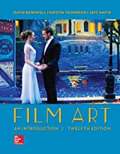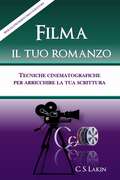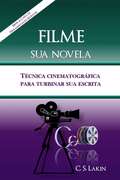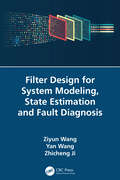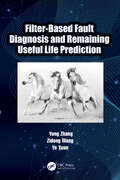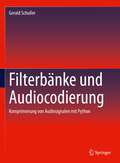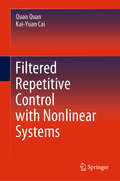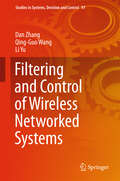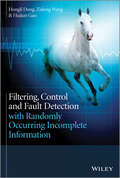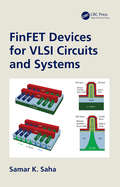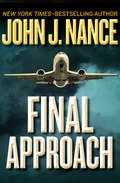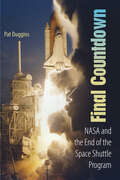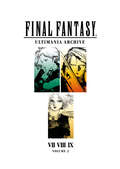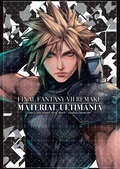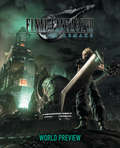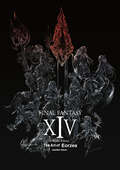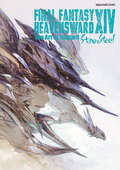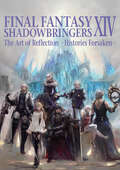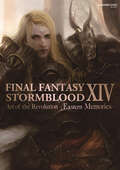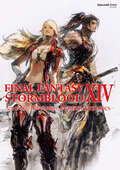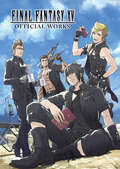- Table View
- List View
Film Art: An Introduction
by Jeff Smith David Bordwell Kristin ThompsonFilm is an art form with a language and an aesthetic all its own. Since 1979, David Bordwell, Kristin Thompson and now, Co-Author, Jeff Smith's Film Art has been the best-selling and most widely respected introduction to the analysis of cinema. Taking a skills-centered approach supported by examples from many periods and countries, the authors help students develop a core set of analytical skills that will enrich their understanding of any film, in any genre. In-depth examples deepen students' appreciation for how creative choices by filmmakers affect what viewers experience and how they respond. Film Art is generously illustrated with more than 1,000 frame enlargements taken directly from completed films, providing concrete illustrations of key concepts. Along with updated examples and expanded coverage of digital filmmaking, the twelfth edition of Film Art delivers SmartBook, first and only adaptive reading experience currently available, designed to help students stay focused, maximize study time and retain basic concepts.
Filma il tuo romanzo: tecniche cinematografiche per potenziare la tua scrittura
by Emiliana Erriquez C. S. LakinVolete scrivere un romanzo visivamente forte? Filma il tuo romanzo analizza in profondità la tecnica cinematografica per gli scrittori di fiction. Nessun altro libro sul mestiere di scrivere vi insegna il segreto di come "Mostrare, non raccontare". Gli autori di best-seller di ogni genere conoscono il segreto per catturare l'attenzione dei lettori mostrando, non raccontando la loro storia. Ma agli scrittori non viene insegnato come "mostrare" le scene in modo cinematografico. Senza un metodo chiaro, conciso, e preciso per la costruzione di scene dinamiche, uno scrittore probabilmente finirà con il creare un romanzo piatto, senza vita. I registi, gli sceneggiatori utilizzano la tecnica cinematografica per creare capolavori visivi, e gli scrittori di romanzi POSSONO adattare i loro metodi alla loro scrittura narrativa. Con "Filma" il tuo romanzo, è possibile potenziare la vostra storia! Sol Stein, nel suo libro Stein on Writing ha detto, "I lettori, condizionati da film e TV, sono abituati a vedere le storie. L'esperienza di lettura. . . è sempre più visiva." Gli scrittori di romanzi di oggi, indipendentemente dal genere, devono imparare la narrazione cinematografica, perché questo è ciò che i lettori vogliono! All'interno, troverete: Il vero segreto del "Mostrare, non raccontare" e come sia tutta una questione di "momenti" Più di una dozzina di "inquadrature" che gli scrittori di romanzi possono prendere in prestito dagli sceneggiatori e dai registi per creare grandi scene Istruzioni su come mettere insieme le inquadrature per creare segmenti di scena cinematografici Esempi da romanzi e sceneggiature che mostrano ogni aspetto della tecnica cinematografica Come elaborare un sistema di immagine tematico delle principali inquadrature, idee dominanti e immagini Modi per utilizzare colori, forme, suoni, e angoli per un effetto subliminale intenzionale
Filme Sua Novela
by C. S. Lakin Ana Claudia AntunesQuer escrever um romance com visual poderoso? Filme sua Novela dirige o olhar em profundidade sobre técnica cinematográfica para os escritores de ficção . Nenhum outro livro escrito para o ofício ensina o segredo de como "mostrar, não dizer".Autores de best-sellers de todos os gêneros sabem o segredo para enganchar os leitores- ao mostrar, não dizer, a sua história. Mas os escritores não são ensinados a "mostrar" cenas de forma cinematográfica. Sem um método claro, conciso e preciso para a construção de cenas dinâmicas, um escritor provavelmente vai acabar com uma novela plana e sem vida.Cineastas, roteiristas e diretores de cinema utilizam a técnica cinematográfica para criar obras de artes visuais, e romancistas também podem fazer o mesmo - adaptando seus métodos em sua escrita de ficção.Ao "filmar" o seu romance, você vai turbinar a sua história!Sol Stein, em seu livro Stein na escrita disse: "Os leitores, transformados pelo cinema e TV, estão acostumados a ver histórias. A experiência da leitura. . . é cada vez mais visual. "Romancistas hoje, independentemente do gênero, necessitam aprender a escrever cinematograficamente, porque isso é o que os leitores querem!Lá dentro de "Filme sua Novela", você vai aprender:O verdadeiro segredo para "mostrar, não dizer" e como tudo se insere no "momento"Mais de uma dúzia de "tomadas de câmera" que os romancistas podem tomar emprestado de roteiristas e diretores para criar poderosas cenas Instrução ativa de como montar as peça de planos de câmera em conjunto para criar segmentos de cenas cinematográficasExemplos de romances e roteiros mostrando cada faceta da técnica cinematográficaComo conceber um sistema de imagem temática de planos-chave, motivos, e imagensManeiras de usar cores, formas, sons, e ângulos para efeito subliminar proposital"Filme sua Novela"
Filter Banks and Audio Coding: Compressing Audio Signals Using Python
by Gerald SchullerThis textbook presents the fundamentals of audio coding, used to compress audio and music signals, using Python programs both as examples to illustrate the principles and for experiments for the reader. Together, these programs then form complete audio coders. The author starts with basic knowledge of digital signal processing (sampling, filtering) to give a thorough introduction to filter banks as used in audio coding, and their design methods. He then continues with the next core component, which are psycho-acoustic models. The author finally shows how to design and implement them. Lastly, the author goes on to describe components for more specialized coders, like the Integer-to-Integer MDCT filter bank, and predictive coding for lossless and low delay coding. Included are Python program examples for each section, which illustrate the principles and provide the tools for experiments.Comprehensively explains the fundamentals of filter banks and audio coding;Provides Python examples for each principle so that completed audio coders are obtained in the language;Includes a suite of classroom materials including exercises, experiments, and examples.
Filter Design for System Modeling, State Estimation and Fault Diagnosis
by Yan Wang Zhicheng Ji Ziyun WangFilter Design for System Modeling, State Estimation and Fault Diagnosis analyzes the latest methods in the design of filters for system modeling, state estimation and fault detection with the intention of providing a new perspective of both theoretical and practical aspects.This book also includes fault diagnosis techniques for unknown but bounded systems, their real applications on modeling and fault diagnosis for lithium battery systems, DC-DC converters and spring damping systems. It proposes new methods based on zonotopic Kalman filtering, a variety of state estimation methods of zonotope and its derived algorithms, a state estimation method based on convex space, set inversion interval observer filtering-based guaranteed fault estimation and a novel interval observer filtering-based fault diagnosis. The methods presented in this text are more practical than the common probabilistic-based algorithms, since these can be applied in unknown but bounded noisy environments. This book will be an essential read for students, scholars and engineering professionals who are interested in filter design, system modeling, state estimation, fault diagnosis and related fields.
Filter-Based Fault Diagnosis and Remaining Useful Life Prediction
by Zidong Wang Yong Zhang Ye YuanThis book unifies existing and emerging concepts concerning state estimation, fault detection, fault isolation and fault estimation on industrial systems with an emphasis on a variety of network-induced phenomena, fault diagnosis and remaining useful life for industrial equipment. It covers state estimation/monitor, fault diagnosis and remaining useful life prediction by drawing on the conventional theories of systems science, signal processing and machine learning. Features: Unifies existing and emerging concepts concerning robust filtering and fault diagnosis with an emphasis on a variety of network-induced complexities. Explains theories, techniques, and applications of state estimation as well as fault diagnosis from an engineering-oriented perspective. Provides a series of latest results in robust/stochastic filtering, multidate sample, and time-varying system. Captures diagnosis (fault detection, fault isolation and fault estimation) for time-varying multi-rate systems. Includes simulation examples in each chapter to reflect the engineering practice. This book aims at graduate students, professionals and researchers in control science and application, system analysis, artificial intelligence, and fault diagnosis.
Filterbänke und Audiocodierung: Komprimierung von Audiosignalen mit Python
by Gerald SchullerDieses Lehrbuch stellt die Grundlagen der Audiocodierung vor, die zur Komprimierung von Audio- und Musiksignalen verwendet wird. Dabei werden Python-Programme sowohl als Beispiele zur Veranschaulichung der Prinzipien als auch für Experimente für den Leser verwendet. Zusammen bilden diese Programme dann komplette Audiocodierer. Der Autor beginnt mit grundlegenden Kenntnissen der digitalen Signalverarbeitung (Abtastung, Filterung), um eine gründliche Einführung in Filterbänke, wie sie in der Audiocodierung verwendet werden, und deren Entwurfsmethoden zu geben. Er fährt dann mit der nächsten Kernkomponente fort, den psycho-akustischen Modellen. Der Autor zeigt schließlich, wie man sie entwirft und implementiert. Schließlich beschreibt der Autor Komponenten für speziellere Kodierer, wie die Integer-to-Integer MDCT-Filterbank und prädiktive Kodierung für verlustfreie und verzögerungsarme Kodierung. Zu jedem Abschnitt gibt es Python-Programmbeispiele, die die Prinzipien veranschaulichen und die Werkzeuge für Experimente bereitstellen. Umfassende Erläuterung der Grundlagen von Filterbänken und Audiocodierung; Bietet Python-Beispiele für jedes Prinzip, so dass fertige Audiocodierer in der Sprache erhalten werden; Enthält eine Reihe von Unterrichtsmaterialien mit Übungen, Experimenten und Beispielen.
Filtered Repetitive Control with Nonlinear Systems
by Quan Quan Kai-Yuan CaiThough there have been significant advances in the theory and applications of linear time-invariant systems, developments regarding repetitive control have been sporadic. At the same time, there is a dearth of literature on repetitive control (RC) for nonlinear systems.Addressing that gap, this book discusses a range of basic methods for solving RC problems in nonlinear systems, including two commonly used methods and three original ones. Providing valuable tools for researchers working on the development of repetitive control, these new and fundamental methods are one of the major features of the book, which will benefit researchers, engineers, and graduate students in e.g. the field of control theory.
Filtering and Control of Wireless Networked Systems
by Dan Zhang Li Yu Qing-Guo WangThis self-contained book, written by leading experts, offers a cutting-edge, in-depth overview of the filtering and control of wireless networked systems. It addresses the energy constraint and filter/controller gain variation problems, and presents both the centralized and the distributed solutions. The first two chapters provide an introduction to networked control systems and basic information on system analysis. Chapters (3-6) then discuss the centralized filtering of wireless networked systems, presenting different approaches to deal with energy efficiency and filter/controller gain variation problems. The next part (chapters 7-10) explores the distributed filtering of wireless networked systems, addressing the main problems of energy constraint and filter gain variation. The final part (chapters 11-14) focuses on the distributed control of wireless networked systems. In view of the rapid deployment and development of wireless networked systems for communication and control applications, the book represents a timely contribution and provides valuable insights, useful methods and effective algorithms for the analysis and design of wireless networked control systems. It is a valuable resource for researchers in the control and communication communities
Filtering, Control and Fault Detection with Randomly Occurring Incomplete Information
by Zidong Wang Huijun Gao Hongli DongIn the context of systems and control, incomplete information refers to a dynamical system in which knowledge about the system states is limited due to the difficulties in modelling complexity in a quantitative way. The well-known types of incomplete information include parameter uncertainties and norm-bounded nonlinearities. Recently, in response to the development of network technologies, the phenomenon of randomly occurring incomplete information has become more and more prevalent. Filtering, Control and Fault Detection with Randomly Occurring Incomplete Information reflects the state-of-the-art of the research area for handling randomly occurring incomplete information from three interrelated aspects of control, filtering and fault detection. Recent advances in networked control systems and distributed filtering over sensor networks are covered, and application potential in mobile robotics is also considered. The reader will benefit from the introduction of new concepts, new models and new methodologies with practical significance in control engineering and signal processing. Key Features: Establishes a unified framework for filtering, control and fault detection problem for various discrete-time nonlinear stochastic systems with randomly occurring incomplete information Investigates several new concepts for randomly occurring phenomena and proposes a new system model to better describe network-induced problems Demonstrates how newly developed techniques can handle emerging mathematical and computational challenges Contains the latest research results Filtering, Control and Fault Detection with Randomly Occurring Incomplete Information provides a unified yet neat framework for control/filtering/fault-detection with randomly occurring incomplete information. It is a comprehensive textbook for graduate students and is also a useful practical research reference for engineers dealing with control, filtering and fault detection problems for networked systems.
FinFET Devices for VLSI Circuits and Systems
by Samar K. SahaTo surmount the continuous scaling challenges of MOSFET devices, FinFETs have emerged as the real alternative for use as the next generation device for IC fabrication technology. The objective of this book is to provide the basic theory and operating principles of FinFET devices and technology, an overview of FinFET device architecture and manufacturing processes, and detailed formulation of FinFET electrostatic and dynamic device characteristics for IC design and manufacturing. Thus, this book caters to practicing engineers transitioning to FinFET technology and prepares the next generation of device engineers and academic experts on mainstream device technology at the nanometer-nodes.
Final Answers
by Greg DinalloGreg Dinallo, the heralded author of Rockets&’ Red Glare and Purpose of Evasion, has written his most chilling and disturbing thriller yet: A novel of intrigue that explores the emotionally charged issue of Vietnam War MIAs. Final Answers is provocative, authentic, and powerful fictionAmong the 58,176 names etched on the long black wall of the Vietnam Memorial in Washington, DC, are names of those who never came home—of MIAs whose families are still waiting for final answers.During a business trip to Washington, a veteran, now a statistics expert, has an experience at the Memorial that will shatter his carefully constructed life with the impact of a Claymore mine. Touching the names carved in the wall, he finds one all too familiar: his own. A. Calvert Morgan understands cold, hard numbers. But how did his name get on the wall? Morgan&’s wife, Nancy, does some research for him that leads him to Kate Ackerman. Kate&’s husband had been listed as missing in action after being shot down in Laos twenty years earlier; during those years, she has joined the National League of Families and become a dedicated MIA activist.At first, Morgan believes that he is part of a bizarre military snafu—a data entry error made in the field. But when Kate guides him to the Army&’s Central Identification Lab in Hawaii, he begins to realize that his &“death&” was not an accident. In the war zone, another man took his name and serial number for his own —and then was killed. Morgan finds out that his impersonator was no ordinary GI He was, in fact, a key player in a macabre conspiracy that reaches back to the poppy fields of Laos.Morgan has set off a deadly alarm; the drug lord is still operating and has targeted him for elimination. Coming after Morgan—a man more comfortable with a computer than a handgun—the hit man commits a murder so brutal that Morgan&’s life is turned into a raging fight for survival.From the San Francisco mortuary that received the bodies of American servicemen during the war to Southeast Asia in the &’90s, Morgan is venturing into ever more violent territory. And he is not alone. Kate Ackerman has joined him on a trip to Thailand—hopeful that her husband is still alive, his fate possibly linked to those who have targeted Morgan for death.Amid Bangkok&’s steamy nightclubs and brackish, twisting canals, their quest pushes them into the jungle, across the Mekong River into Laos, where they move toward a brutal final answer to the mystery of Vietnam MIAs . . .Electrifying and filled with suspense, Final Answers confirms Greg Dinallo&’s reputation as a novelist who poses daring questions, takes extraordinary risks, and delivers searing excitement from first page to last.
Final Approach
by John J. NanceA government investigator looks into the cover-up of a deadly plane crash in this aviation thriller from the New York Times–bestselling author of Lockout. In the control tower at Kansas City International Airport, all the radar displays are red. But for the experienced pilots of North America Airlines, the thunderstorms aren&’t the problem: NAA has been cutting costs to stave off bankruptcy, and will do anything to keep their planes in the air. Unfortunately, no matter what they do, one is on its way down. After the aircraft collides with another plane on the Kansas City runway, in one of the worst aviation disasters of the decade, National Transportation Safety Board investigator Joe Wallingford arrives on the scene. As he studies the wreckage and pieces together the events that led to the tragedy, he realizes there&’s far more at play than pilot error or equipment malfunction. Wallingford will have to risk his career—and perhaps even his life—to solve the puzzle of the crash.
Final Countdown: NASA and the End of the Space Shuttle Program
by Pat DugginsThe Space Shuttle was once the cornerstone of the U.S. space program. However, each new flight brings us one step closer to the retirement of the shuttle in 2010. Final Countdown is the riveting history of NASA's Space Shuttle program, its missions, and its impending demise. It also examines the plans and early development of the space agency’s next major effort: the Orion Crew Exploration Capsule.Journalist Pat Duggins, National Public Radio's resident "space expert," chronicles the planning stages of the shuttle program in the early 1970s, the thrills of the first flight in 1981, construction of the International Space Station in the 1990s, and the decision in the early 2000s to shut it down. As a rookie reporter visiting the Kennedy Space Center hangar to view the Challenger wreckage, Duggins was in a unique position to offer a poignant eyewitness account of NASA's first shuttle disaster. In Final Countdown, he recounts the agency's struggle to rebound after the Challenger and Columbia tragedies, and explores how politics, scientific entrepreneurship, and the human drive for exploration have impacted the program in sometimes unexpected ways. Duggins has covered eighty-six shuttle missions, and his twenty-year working relationship with NASA has given him unprecedented access to personnel. Many spoke openly and frankly with him, including veteran astronaut John Young, who discusses the travails to get the shuttle program off the ground. Young's crewmate, astronaut Bob Crippen, reveals the frustration and loss he felt when his first opportunity to go into space on the first planned space station was taken away.As the shuttle program winds down, more astronauts may face similar disappointments. Final Countdown is a story of lost dreams, new hopes, and the ongoing conquest of space.
Final Fantasy Ultimania Archive Volume 2
by Square EnixExplore the art and adventure of the quintessential entries in the Final Fantasy saga with this gorgeous 300-plus-page hardcover.Collecting concept art, design notes, creator retrospectives, and more from Final Fantasy VII, Final Fantasy VIII, and Final Fantasy IX, Dark Horse's journey through the creation of the groundbreaking role-playing masterpiece continues!Dark Horse and Square Enix are thrilled to present the second of three volumes that officially translate Square Enix's detailed history chronicling the creation of the Final Fantasy franchise's seventh, eighth, and ninth games. Filled with captivating art and creator commentary, Final Fantasy Ultimania Archive Volume 2 remains completely authentic to its Japanese source material with unrivaled access for a Western audience. This prestige compendium is a must-have addition for any Final Fantasy enthusiast's collection.
Final Fantasy Ultimania Archive Volume 3
by Square EnixThe journey through the creation of the groundbreaking video games continues with this breathtaking volume, featuring hundreds of pieces of concept art, design notes, and creator retrospectives from the original team behind the making of Final Fantasy X, Final Fantasy XI, Final Fantasy XII, Final Fantasy XIII, and Final Fantasy XIV.Art, commentary, and lore from a transformative era in the indispensable role-playing franchise, collected in a beautifully printed 300-plus-page hardcover. Foray into one of gaming's most iconic properties, exploring beautiful art and incisive commentary behind five of the most memorable entries in the Final Fantasy saga.Final Fantasy Ultimania Archive Volume 3 authentically translates original Japanese source material to present unparalleled access for a Western audience. This incredible tome is a must-have addition to any Final Fantasy enthusiast's collection.
Final Fantasy VII Remake: Material Ultimania (Final Fantasy VII)
by Square Enix Studio BentStuff Digital HeartsPacked with art and visual reference materials used during development of the game, this deluxe, hardcover volume is a must-have for fans of Final Fantasy VII Remake.Final Fantasy VII Remake: Material Ultimania presents a comprehensive collection of production art and CG art assets, including character models and illustrations, locations and backgrounds, accessories, weapons, enemies, and more, all accompanied by staff commentary. This volume also includes detailed costume references, cutscene storyboards, song liner notes from the sound staff, and Q & A interviews with the Japanese voice actors.At over 300 pages, this full-color, jacketed, hardcover book is a visual tribute to the stunning new rendition of one of the most beloved RPGs of all time.
Final Fantasy VII Remake: World Preview (Final Fantasy VII)
by Square EnixA full-color, lavishly illustrated introduction to the world of Final Fantasy VII Remake, presenting information on characters, settings, gameplay, and more!With its captivating characters, striking visual design, and intense gameplay, Final Fantasy VII set a new standard for the RPG genre and became one of the top video game releases of all time. Now, with Final Fantasy VII Remake, players return to Midgar in a stunning new rendition of a timeless classic. This World Preview volume offers both new players and longtime fans essential information on characters, settings, gameplay, and more, as well as introductory comments from producer Yoshinori Kitase and director Tetsuya Nomura.
Final Fantasy XIV: A Realm Reborn -- The Art of Eorzea -Another Dawn- (Final Fantasy XIV)
by Square EnixA new edition of the first official art book for Final Fantasy XIV, boasting over 1,000 pieces of full-color artwork, along with comments from the developers and an exclusive bonus item code! (NOTE: E-book edition does not include bonus item code.)Featuring artwork from character designer Akihiko Yoshida and the Final Fantasy XIV art team, A Realm Reborn: The Art of Eorzea –Another Dawn– collects the illustrations created throughout the process of developing the groundbreaking online game. This 300-page, full-color volume showcases beautiful concept designs, environment artwork, sketches and more, accompanied by production notes and comments from the artists. Includes an exclusive bonus item code for an in-game Wind-up Enterprise minion! The first volume in the line of Final Fantasy XIV official art books.
Final Fantasy XIV: Heavensward -- The Art of Ishgard -Stone and Steel- (Final Fantasy XIV #1)
by Square EnixA beautiful new edition of the official art book for Final Fantasy XIV: Heavensward. Featuring hundreds of full-color illustrations and an exclusive bonus item code, this is a must-have for collectors and fans! Book one of a two-book set. (NOTE: E-book edition does not include bonus item code.)The Art of Ishgard -Stone and Steel- presents the concept art and planning images that became the foundation for the aesthetics of Final Fantasy XIV: Heavensward. Each page of this gorgeous, high-quality volume is packed with full-color art and character sketches, as well as lore-related drawings of equipment, environments, and more. Book one of a two-book set with The Art of Ishgard -The Scars of War-.Includes an exclusive bonus item code for an in-game Wind-up Relm minion! The second volume in the line of Final Fantasy XIV official art books.
Final Fantasy XIV: Shadowbringers -- The Art of Reflection -Histories Forsaken- (Final Fantasy XIV #1)
by Square EnixA gorgeous, oversized, full-color art book showcasing the artwork from the massively popular online video game Final Fantasy XIV. Volume one of a two-volume set with The Art of Reflection -Histories Unwritten-.(NOTE: E-book edition does not include bonus item code.)Delve into the breathtaking world of Final Fantasy XIV: Shadowbringers in this deluxe volume featuring hundreds of beautiful illustrations of characters, environments, equipment, and more. Offering concept art, reference images, and messages from the artists, this book is a must-have not only for fans of the game but for any who appreciate top-tier game art.Includes an exclusive bonus code redeemable for a Wind-up Dulia-Chai minion! The sixth volume in the line of Final Fantasy XIV official art books.
Final Fantasy XIV: Shadowbringers -- The Art of Reflection -Histories Unwritten- (Final Fantasy XIV #2)
by Square EnixThe second volume of a two-volume set of the official art books for Final Fantasy XIV: Shadowbringers, featuring hundreds of pages of full-color art and an exclusive bonus item code!Covering content through the end of the Shadowbringers expansion, this deluxe, large-format book showcases artwork for YoRHa: Dark Apocalypse, Eden&’s Verse & Eden&’s Promise, Save the Queen, and much more. The Art of Reflection -Histories Unwritten- also includes detailed illustrations of characters, equipment, dungeons and trials, as well as messages from the artists. Volume two of a two-volume set with The Art of Reflection -Histories Forsaken-.Includes an exclusive bonus item code for a Wind-up Runar minion! (NOTE: E-book edition does not include bonus item code.)The seventh volume in the line of Final Fantasy XIV official art books.
Final Fantasy XIV: Stormblood -- The Art of the Revolution -Eastern Memories- (Final Fantasy XIV #2)
by Square EnixThe second volume of a two-volume set of the official art books for Final Fantasy XIV: Stormblood. This new edition features hundreds of pages of full-color art, a sticker sheet, and an exclusive bonus item code! (NOTE: E-book edition does not include bonus item code.)Return to Eorzea with the Warrior of Light via this exhaustive collection of almost one thousand pieces of concept art and illustrations, including character designs, field areas, dungeons, monsters, equipment, and more. Covering content through the end of the Stormblood expansion, The Art of the Revolution -Eastern Memories- also features messages from the art team, along with a job stone and minion sticker sheet. Book two of a two-book set with The Art of the Revolution -Western Memories-.Includes an exclusive bonus item code for an in-game Dress-Up Tataru minion! The fifth volume in the line of Final Fantasy XIV official art books.
Final Fantasy XIV: Stormblood -- The Art of the Revolution -Western Memories- (Final Fantasy XIV #1)
by Square EnixShowcasing the stunning artwork of Final Fantasy XIV: Stormblood, this new edition of the official art book offers hundreds of full-color illustrations in a collectors' quality volume, along with an exclusive bonus item code. Book one of a two-book set. (NOTE: E-book edition does not include bonus item code.)Experience the rich world of Final Fantasy XIV: Stormblood once more via this exhaustive collection of concept art and illustrations, including character designs, field areas, dungeons, monsters, equipment, and more. The Art of the Revolution -Western Memories- also features commentary from the art team on how costumes are created. Book one of a two-book set with The Art of the Revolution -Eastern Memories- Includes an exclusive bonus item code for an in-game Wind-up Yotsuyu minion! The fourth volume in the line of Final Fantasy XIV official art books.
Final Fantasy XV Official Works
by Square EnixA full-color, oversized, hardcover tome that faithfully adapts the original Japanese material, detailing the creation of the most recent entry in the Final Fantasy saga!Final Fantasy XV's world of Eos is filled with wonderous scenery, larger-than-life creatures, diverse cultures, and treacherous foes. Experience hundreds of pieces of detailed design work composed lovingly for fans of the unique sci-fi fantasy world. This volume collects complex lore, insightful commentary, comprehensive data, and dazzling concept art, all beautifully bound in this richly detailed hardcover!Square Enix and Dark Horse Books present a superbly curated collection of Final Fantasy XV content that any fan will cherish.
